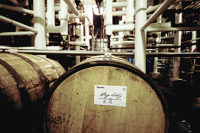The MillerCoors brewery in Wisconsin is located on a 90-acre campus in the heart of Milwaukee, in what used to be the corporate headquarters for Miller Brewing — MillerCoors now has its headquarters in Chicago. The brewery, which runs to 2.3 million square feet under roof, turns out more than 8 million barrels, which is equivalent to 248 million gallons, a year of Miller Lite, Miller Genuine Draft, Coors Banquet, Coors Light and other Miller and Coors products, in sizes ranging from 12 ounces to kegs.
North and South Brew Houses brew all the beers produced, which are subsequently filled on one of eight packaging lines. Turning out both Miller and Coors products is one of the facility’s major challenges. The differences between the two products extend to packaging as well as formulation. For one thing, most Miller products are heat-pasteurized after filling, while almost no Coors products are. This means that Coors products must undergo extra-fine filtration in an extra-clean environment to reduce the level of microorganisms enough to confer a shelf life comparable to pasteurized products, which is about 17 weeks.
Currently, the brewery uses three cleanroom systems, two for bottles and one for cans, to help meet that requirement. They house one 165 valve filler for cans and two 100-valve fillers that run up to 700 bottles per minute each. The cleanrooms maintain positive pressure to stay filled with air that’s HEPA-filtered to less than 100 parts per million.
The cleanrooms are relatively old technology: They’ve been in place for 25 years. MillerCoors plans to phase out the cleanrooms and substitute newer technology for unpasteurized products. Some of these are already in use; conventional filler cleanrooms are now replaced with aseptically controlled “shrouds” that maintain sterile conditions as the containers are filled.
Beer gets pasteurized at the Milwaukee brewery in one of two ways. The conventional way is for the filled, sealed bottles or cans to go through a pasteurizing hot-water bath, which heats them to about 140-degrees Fahrenheit and then cools them down. Other beers are “flash-pasteurized” in a manner similar to milk: they’re heated, then immediately cooled just before filling. The bottles also pass through a warming tunnel, to be warmed only to room temperature so they don’t “sweat” and create problems for the secondary packaging.
Balancing act
One of the biggest balancing acts the Milwaukee brewery must deal with is the use of bulk glass versus reshippers. The reshipper system is favored by the majority of American brewers, and is used by MillerCoors for its six-pack paperboard baskets of glass bottles — a popular secondary packaging for bottles. Empty bottles arrive in baskets, preformed and nestled into corrugated cases, and are plucked from there to be filled and returned to the baskets.
Some bottles arrive in bulk, on pallets secured by stretchwrap and separated by slipsheets. A depalletizer removes the slipsheets with vacuum cups, which get reused several times until they show signs of wear. The bottles are removed, transported to an overhead level, filled and packaged in configurations ranging from standard basket six-packs to 12- and 18-pack paperboard cases.
For the former, a case packer unfolds the baskets from blanks. They are raised over the two-wide line of bottles and then lowered, with their bottoms hanging open at the side, over six of the bottles. The bottoms are then locked into place without glue using a hole-and-tab setup. A case-packer then wraps a corrugated case around four of the six-pack baskets.
“You can’t hear a bottle move in this pack,” says Dave Klante, vice president, engineering and packaging, seizing and shaking one of the cases to prove his point. “It’s very tight.”
Bulk glass saves space, because more empty bottles can be shipped on a bulk pallet, and the basket and case blanks take up less room than erected ones. Over the long term, MillerCoors plans to convert as much of its glass bottling to bulk operations as possible.
At the Milwaukee brewery as well as its other facilities, MillerCoors is making commitments to sustainability that won’t be obvious to consumers. One is as simple as the kind of waterless lube used on the conveyors. The brewer is investing in conveyor lubrications which will save on water, improve equipment life, and improve plant sanitation for conveyors and floor cleaning.
Another sustainability-motivated transition involves pallets. MillerCoors has transitioned from standard wooden to plastic pallets for both incoming supplies and outgoing product. The pallets not only are more durable they are less liable to break down and jam automatic palletizers.
Quality control is an ongoing challenge, especially for a high-volume operation like this. Quality control encompasses both in-line and sampling systems. The former include X-ray inspection systems which check inside bottles and cans for proper fill levels, and inside cases for missing bottles. The latter encompasses an ongoing sampling program that draws a set number of cans from the seamers. (Each seaming head leaves a dimple in a different place on the can as an identifying feature.) Quality-control personnel look at sidewall thickness, curl integrity, seal integrity and other parameters.
“At 2,000 cans a minute, we can make a big problem quickly,” Klante says. “We always have to stay ahead of it, so we’re making good beer, one six-pack at a time.” BI
Pan Demetrakakes is a contributor to Food & Beverage Packaging, a sister publication of Beverage Industry magazine. Food & Beverage Packaging selected MillerCoors as its Beverage Packager of the Year in its May 2011 issue. For more information, visit foodandbeveragepackaging.com.


